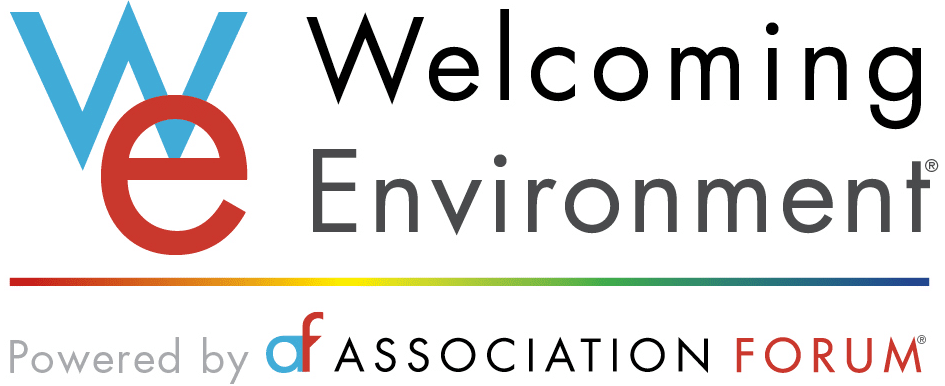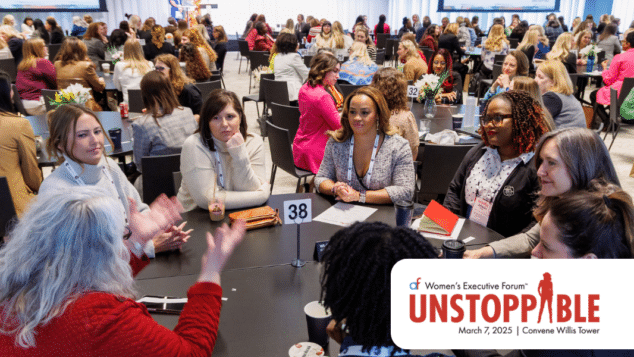Nurturing A Welcoming Environment® for Association Staff

One of the association’s core values is to be a Welcoming Environment®. Association Forum provides resources and education to support organizations in their efforts to create and sustain environments where everyone feels welcomed, represented, engaged, inspired, and empowered. In addition, the Welcoming Environment Organizational Award is presented annually to an association that has demonstrated exemplary outcomes in providing an inclusive and welcoming environment and culture.
 Most welcoming environment initiatives primarily focus on members and typically apply to member benefits, events, publications, programs, and volunteer opportunities. While these efforts are important and valuable, they are exponentially more effective and meaningful when the organization also prioritizes nurturing a welcoming environment for their association staff. For some leaders, this concept might be obvious and serves as the solid foundation for their efforts targeted at members. But other association leaders might find opportunities for improvement and the chance to strengthen the vital connection between the culture experienced by members and the culture experienced by staff.
Most welcoming environment initiatives primarily focus on members and typically apply to member benefits, events, publications, programs, and volunteer opportunities. While these efforts are important and valuable, they are exponentially more effective and meaningful when the organization also prioritizes nurturing a welcoming environment for their association staff. For some leaders, this concept might be obvious and serves as the solid foundation for their efforts targeted at members. But other association leaders might find opportunities for improvement and the chance to strengthen the vital connection between the culture experienced by members and the culture experienced by staff.
To assess how well your association is creating a welcoming environment for your internal team, and identify opportunities for improvement, here are some key areas to explore.
Hiring Process
An organization’s culture is already being showcased to potential employees during the recruiting and selection process. Review your job postings and read them from the vantage point of a job seeker. Do they reflect an inclusive culture? Have you considered removing unnecessary prerequisites such as college degrees or specific years of experience – especially from entry-level or early-career jobs? Are you posting on job boards that reach diverse applicants?
Once you’ve reviewed resumes and begin interviewing, do you treat all applicants with respect and consideration? Are you making appropriate accommodations when requested? Do you keep lines of communication open during the process to avoid “ghosting” interested candidates? After a job offer has been accepted, do you follow-up with all applicants in a timely manner?
The association community is tight-knit and word spreads quickly about employers who don’t treat people with dignity and integrity. While you may not hire someone for a given position, your paths could easily cross again. A candidate with a positive experience could be the source of referrals for future candidates.
Onboarding
The importance of the first days, weeks, and months in a new job should not be underestimated. When an organization puts effort and resources into this critical stage, the ROI is high. So, make sure HR (or whoever handles HR duties in your organization) and the new hire’s manager are deliberate and thoughtful in ensuring that onboarding is more than filling out paperwork and going out to lunch on the first day. A welcoming environment can be exhibited in a variety of ways during an employee’s early days leading to significant boosts in performance, morale, and retention.
Your onboarding process might include scheduling individual or team meetings with all departments, providing time to personally connect with association leadership, partnering with a colleague, and meeting with HR to go through the employee handbook and benefit offerings. Remember to introduce your new employee at any all-staff events. These ideas can be easily implemented in remote, hybrid, or in-person settings. Management should plan and execute these initiatives carefully, ensuring that they’re effective and that they don’t fall through the cracks.
Workplace Policies
There is an abundance of workplace policies and practices that enable associations to create and nurture a welcoming environment. “Policies” are traditionally committed to writing in an employee handbook or policy manual, and “practices” are what really happens or are deemed acceptable in an organization. There are times when policy and practice don’t sync up, which can be confusing and even legally risky. If that’s an issue in your organization, your leadership team should work on shoring up the discrepancies to bring policies and practices into alignment.
Some of the policies that matter most today involve work-life balance. Many job seekers won’t even consider open positions that don’t allow for some flexibility in where and when they work. Employers experience a notable increase in applicants when they advertise remote or hybrid scheduling options. If your association has policies that allow for flexibility to improve work-life integration, you should seize the opportunity by communicating this clearly to your team members. Consider offering examples of how other team members tap into these policies to spend more time with their children or parents, minimize long commutes, or devote time to other personal interests. Encourage staff to make proposals for flexible work arrangements that clearly demonstrate the mutual benefits. In my experience, employees who create the plan themselves are more committed to making it successful.
Another popular workplace policy addresses professional development. There are several ways that associations can support employees’ learning and growth. Options include formal tuition reimbursement programs, e-learning, mentorship programs, volunteerism, industry conferences, and networking events. The opportunities are endless.
Again, meeting employees where they’re at, and supporting them in a way that’s meaningful and valuable to them is most effective. Some development options involve a financial investment, and others may be less costly but involve time and support from management or peers. Studies show that Millennials and Gen Z employees are interested in career growth and will choose to stay with employers who invest in them.
Worth the Commitment
A genuine commitment to making your association a welcoming environment for your members and staff takes ongoing attention. It requires consistent day-to-day behaviors, as well as periodic course corrections when mistakes are made or policies need to be revised. Employees’ needs and preferences will continue to evolve, requiring the consideration of new policies and benefits. Leaders must serve as role models, but an authentic welcoming environment can only be achieved when everyone on the team, including managers and staff members, understands their unique role in ensuring that everyone feels that they belong.
Organizations that invest in a welcoming environment for their members as well as their staff will reap a plethora of rewards including increased collaboration, greater innovation, and amplified engagement. Set some time aside to assess your current effectiveness and take the necessary steps to elevate your efforts.
Tags
Related Articles
Tips for Creating a Welcoming Meeting Environment
Creating a truly inclusive annual meeting means going beyond ADA compliance—discover how one association builds...
POV: My First Time at Women’s Executive Forum™ Was Inspiring and Invigorating
A first-time attendee of the Women’s Executive Forum 2025 reflects on the event’s inspiring energy,...
It’s Not Too Late! Celebrate Women’s History Month in March
Celebrate Women's History Month in Chicago with these five impactful ideas to honor, empower, and...




